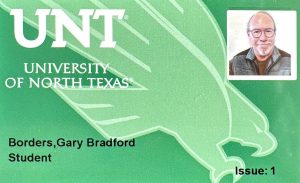Reluctantly Using the Oxford Comma in Grad School
I am having to get used to using the Oxford comma while writing. It is not an easy transition for someone reared on the Associated Press Stylebook.
The Oxford, aka the serial comma, is the last comma in a list — as in red, white, and blue. See that last comma? Those of us taught to consider the AP Stylebook as the Bible of writing always leave it out. That is the style dictated in the punctuation guide of the venerable handbook, which turns 70 this year. It is two years older than me.
Now I am enrolled in two online graduate courses in the University of North Texas College of Information, seeking a certificate in Archival Management by year’s end. I am starting the third week of reading several journal articles for each course, watching a video or two, and then writing about that week’s topic, plus taking quizzes. And grappling with the rules of a different stylebook, the Publication Manual of the American Psychological Association, popularly known as the APA.
My brain hurts.
APA, on page 155 of the current edition, states that a comma is required “between elements in a series of three or more items, including before the final item; this last comma is called a serial comma or Oxford comma.” It is called the latter because the style manual of the Oxford University Press has dictated that comma be there for more than a century. One can blame Horace Hart for the Oxford comma. As Controller of the Press at OUP in 1905, he compiled his Rules for Compositors and Readers and included the serial comma in what is still in print as Hart’s Rules.
For someone who has been writing under the rules of AP style for about a half century, trying to remember to add the Oxford comma is akin to ordering me to root for the Yankees when they are playing the Red Sox. It goes against my grain. I am not opposed to tossing in commas when necessary to provide clarity to the reader and do so quite often. But the Oxford comma rarely provides that clarity. It is unnecessary. That is my position.
People are quite passionate about the Oxford comma on both sides of that little squiggly mark. I am currently in the online, academic version of Rome, aka Denton, so I shall do as they do and insert the Oxford comma even into simple lists. But do not expect me to like it.
I also am required to follow APA style for citations. I have no issues with that, other than I have never used it. The first — and thus far only — book I wrote for an academic pr ess (University of Texas Press) required the use of the Chicago Manual of Style. That is the style where you have a little bitty number above the reference, and then an endnote or a footnote. (A footnote is at the bottom of the page; an endnote is either at the back of the book, or the end of the chapter.)
ess (University of Texas Press) required the use of the Chicago Manual of Style. That is the style where you have a little bitty number above the reference, and then an endnote or a footnote. (A footnote is at the bottom of the page; an endnote is either at the back of the book, or the end of the chapter.)
APA requires an in-text citation (Borders, 2023) and then a bibliography. Daughter Abbie, also enrolled at UNT getting her master’s in library science, has been very helpful, installing an extension on my web browser that generates the proper format for the citation. Kids, these days. Thank goodness she is in the same program, showing the old man all these high-tech tricks.
I am genuinely enjoying being back in graduate school. A few weeks ago, I took a selfie and uploaded it to a link to obtain my UNT ID card. The card arrived about a week later: Gary Bradford Borders. Student.
I like the sound of that, even if it means I have to use an Oxford comma.
Leave a reply
Fields marked with * are required











